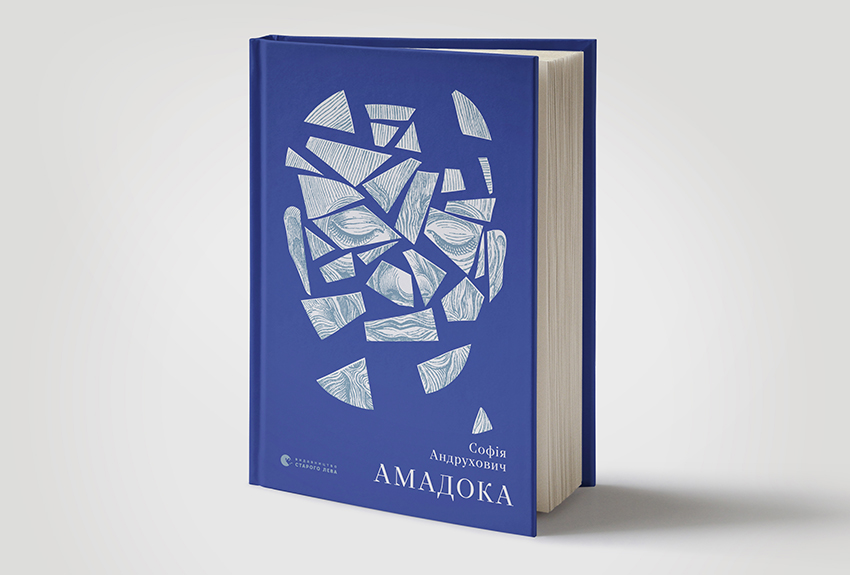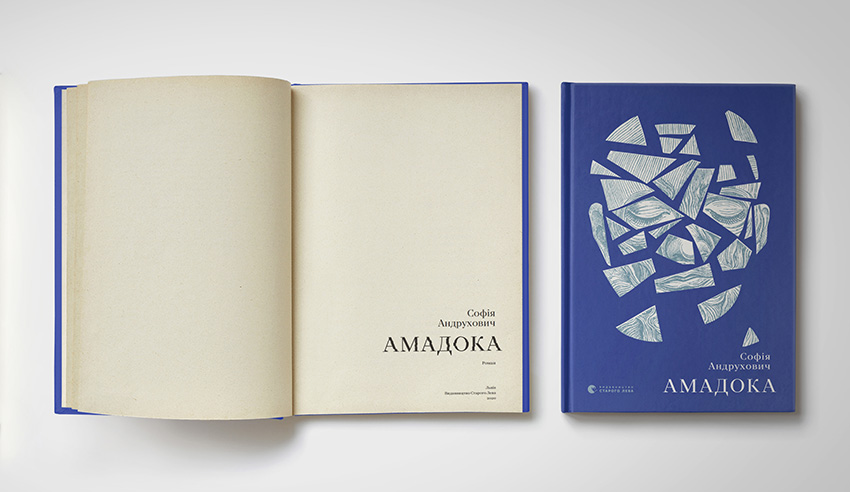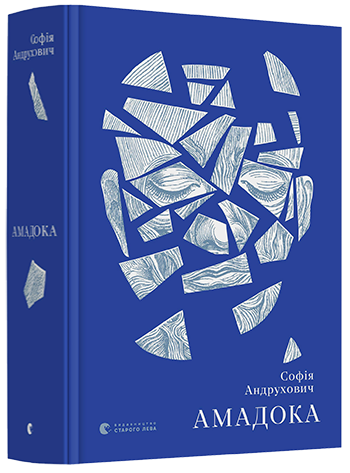YOU CAN LIVE YOUR WHOLE LIFE WITHOUT NOTICING YOU EXIST

What can be done if there is no reliable, official history of one’s community? A possible solution is to search for memories, artifacts, documents and attempt to reconstruct some semblance of the past. The novel is one such approach: a safe environment in which to conduct research, for a work of fiction – even when writing about real events – is protected by the flow of words. It is particularly useful when writing about crucial historical events that are mostly brought up in discussions surrounding political debates online or in the media: that is, when they are discussed at merely the surface level.
by Bohdana Neborak, Apofenie
This approach is taken in Amadoka (2020), Sofia Andrukhovych’s 832-page volume of fiction. The title of the novel takes its name from the mystical lake in Eastern Europe which was once described by Herodotus and depicted by medieval cartographers before it completely disappeared off the map around the 17th century. How can a place be remembered if it has completely disappeared off the map, from the land? This simple metaphor of the lake might seem like the key to understanding the text, but I propose to think of it as a method used by Andrukhovych to raise important questions throughout the novel. Amadoka is a huge undertaking to understand how collective memory works through the prism of individual memories. It is also a significant attempt to connect individuals and periods from Ukrainian as well as East European history which were previously interpreted as distinct from one another, such as Skovoroda and the Ukrainian baroque; World War II and the Holocaust; Stalin’s Great Terror of the 1930s; and the current war in Donbas. Together, they begin to sketch an ideological framework that is strengthened by the contemporary storyline: a young man loses his memory after being wounded in the current Russo-Ukrainian war. Shortly after he wakes up in the hospital, a woman named Romana shows up and claims to recognize the man, named Bohdan, and declares herself to be his wife. Romana persistently tries to help Bohdan regain his lost memories. She knows his family history, professional passions, the necessity of leaving for war, and, naturally, their love story. The couple’s personal journey reflects how many of the characters in Andrukhovych’s novel struggle with constructing their own individuality, identity, and history, ultimately raising the question of what is created and what is destroyed throughout the course of such journeys. After all, the delineation of history often works to the advantage of a specific group of people, while at the same time narrowing the scope of rights of another group making claims to the same historical period or event.
Throughout the novel, the reader meets a multitude of characters: plastic surgeons, psychiatrists, archaeologists, writers, statesmen, KGB officers. Many of them raise a series of doubts in the reader after sounding off on their own versions of past events. Attentive readers will pick up on certain quotes or allusions to literary works, letters, and research that might make the text seem credible but the point of these contradictions is to reveal a complicated ecosystem where no objective truth can be found when discussing the past and the facts, when present, may be uncomfortable when drafting a black-and-white picture of both collective and individual memory. Romana, who works in the archives of St. Sophia’s Cathedral in Kyiv, is a prime example of an unreliable narrator: she lives in the apartment of an old plastic surgeon, even though she commutes to work from the suburbs of Kyiv. She rushes to the warzone in Eastern Ukraine to save Bohdan. She knows a story about everyone and even when she doesn’t, people are often frank and open with her. At the same time, no one seems to know anything about Romana. The reader might begin to wonder if Romana is truly the woman she says is, or if she is intentionally misleading us.
The “unreliable narrator” is a trope defined by Wayne C. Booth in The Rhetoric of Fiction (1961) and broadly used in both cinematography and popular fiction. It assuringes tension and intrigue and engages the reader or spectator in the plot. As Kundera noted in The Depreciated Legacy of Cervantes, “Man … has an innate and irrepressible desire to judge before he understands.” Likewise, Andrukhovych has said in interviews that she is simply asking questions rather than proposing answers to them.
The novel has yet to be translated into English, but I would like to dwell upon the chapter “Impenetrable” (part two of Amadoka) as it tells us the story of the existentialist writer Viktor Petrov (more widely known by his pen name V. Domontovych) and the “Executed Renaissance”, the mass persecution of Ukrainian artists during the Great Terror. Petrov is an important historical figure for Bohdan because he was an interdisciplinary person that knew a lot about life in a time of radical changes. Petrov’s memory offers him a source of intellectual passion: a scientist, archaeologist and fiction writer, whose texts and ideas Bohdan uses “to move away from the places from which you wish to disappear”. The personality of Petrov-Domontovych appears to be a key to understanding the kind of person Bohdan, without any memories of his past life, could be. Petrov’s contemporaries called him “Doctor Paradox”. However, Petrov’s biography is not only a distinguished life to be emulated: it is a personal tragedy of a man living under a totalitarian regime.
The life of the Ukrainian intelligentsia in the 20th-century under the Soviet regime was defined by a seemingly endless sequence of alterations, concealments, changes, and deprivations of beliefs. So many Ukrainian writers and artists were killed that they are known today as “the Executed Renaissance”. At the Solovki prison camp, more than one thousand Ukrainian prisoners were executed between 27th October and 4th November 1937. How political persecution and mass murder on such a large scale was even possible remains a question. Among those killed was Mykola Zerov – poet, translator, literary scholar, colleague, and romantic rival to Viktor Petrov. Zerov died and Petrov survived, the latter finding his way back to Kyiv after collaborating with the Nazis, immigrating to and working in Munich and later in Moscow at archeological excavation sites of Scythian burial mounds. There he observed that Scythian wives were buried with their husbands; the last will and testament of Sofia Zerova, Petrov’s wife – the widow of Mykola Zerov – was to have her final resting place in Petrov’s tomb. Readers may ascertain this at the Kyiv military cemetery where the epitaphs of the couple are placed one above the other.
In Munich, Petrov wrote the short chronicle Ukrainian Culture Actors – Victims of Repressions (published in New York 1959) where he briefly reviewed the background of the Great Terror and the personal stories of the victims. Petrov was a master of the biographical novel and partly used this approach to document the horrors he had witnessed. One of the people he wrote about was Zerov, who had translated Virgil’s Aeneid into Ukrainian, and was later accused of counterrevolutionary activities and terrorism: “A Mauser and a shot in the back of the head were not only the principles of the state system but the literary system”.
Sophia Andrukhovych uses the same medium to write about Petrov’s generation. The reader meets Petrov not just as a supposed secret agent but a man who misses his beloved and constantly complains about his stomach. Did Petrov and Zerova have the courage to remember the lives they had once lived? What questions did they ask each other? Was their love a pure feeling or a consequence of the harsh reality that they had lived through? We will never know – but we can try to imagine. Victor Petrov refused to become a part of the Ukrainian Soviet literature world: his last novel was written during the Second World War and published in 1948 from abroad. He was forgotten as a writer, but nevertheless, considered by some to be a privileged survivor. He was eventually reintroduced into the literary discourse with amendments to his complicated past in the 1990s but questions still remain. How was he able to stay alive, while so many of his peers perished? Why was he a collaborator? How did he escape from Germany? Was he a secret agent or not? The questions are endless, and this is perhaps why he did not truly belong to the canon of Ukrainian literature produced during the Soviet Era.
Mykola Zerov was rehabilitated in 1958, after Stalin’s death. In 1966, a book of selected works by Zerov was published in Kyiv. It was compiled by his widow Sofia, who points to “the closest participation of V. Petrov and G. Kochur” ( Kochur was the translator and student of Zerov). Zerov became a part of the Ukrainian Soviet literature canon but his status in academic studies, publications was less than desirable. His work was partly present at libraries and remembered by separate friends but was not allowed to be quoted, highlighted, that is, rehabilitated. This is a consequence of Soviet censorship.

The period between the Great Terror and so-called rehabilitations in the 1950s was a kind of collective, structural amnesia. How many years does one need to forget or make oneself forget the world he lived in? It seems that twenty years is enough. As with Amadoka lake, memory may disappear. What does one need to return that memory? In his book In a Long Queue: The Problems of Rehabilitation, George Shevelev defines the three dangers of rehabilitation: the danger of silence, the danger of repainting, and the danger of the wrong estimation: “All in all there is one general thing behind the rehabilitations of any people and all artists: the rehabilitation of history”. The fully rehabilitated Zerov was discovered by literary scholars only in the 1990s and the years that followed.
The invitation of an unreliable narrator seems safe when talking about traumatic or complicated experiences: they start each sentence with the question “What if…?” and the answers are endless. In the fictional world of Amadoka the reader may come to discover the harsh reality of the Soviet regime by reading about Petrov’s life: a reality where the law is subservient to the will of the communist party. And so a person is considered free under the Constitution but cannot even decide where to live, what to do for a living, or when to marry their beloved. Such discoveries are not exclusive to Soviet history. Official history is comfortable and laconic, whereas history, in general, is much more uncomfortable and complex and even unforgiving. But if you are drawn into it and learn how to navigate the waves of contradictions, then it becomes a part of you, and cannot be used against you. Personal history finds its roots in memories and, as one of Amadoka characters says: “I came from memory, not a fertilized egg”. He is a well-known doctor – a typical representative of the urban intelligentsia who recognizes the outstanding value of memory.. In the end, even he still does not want to confront all his memories and deal with them.
Sofia Andrukhovych offers the reader a series of individual memories which sketch a profound portrait of East European history, and of Ukrainian history in particular. She compels us to wonder how flexible, variable, and treacherous one's memory can be. Each reconstruction of individual identity is to be paid, but Andrukhovych looks for a way to have the price reduced: this way is fiction.






Коментарі
Щоб залишити коментар, необхідно